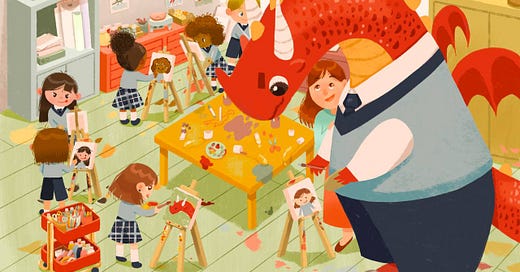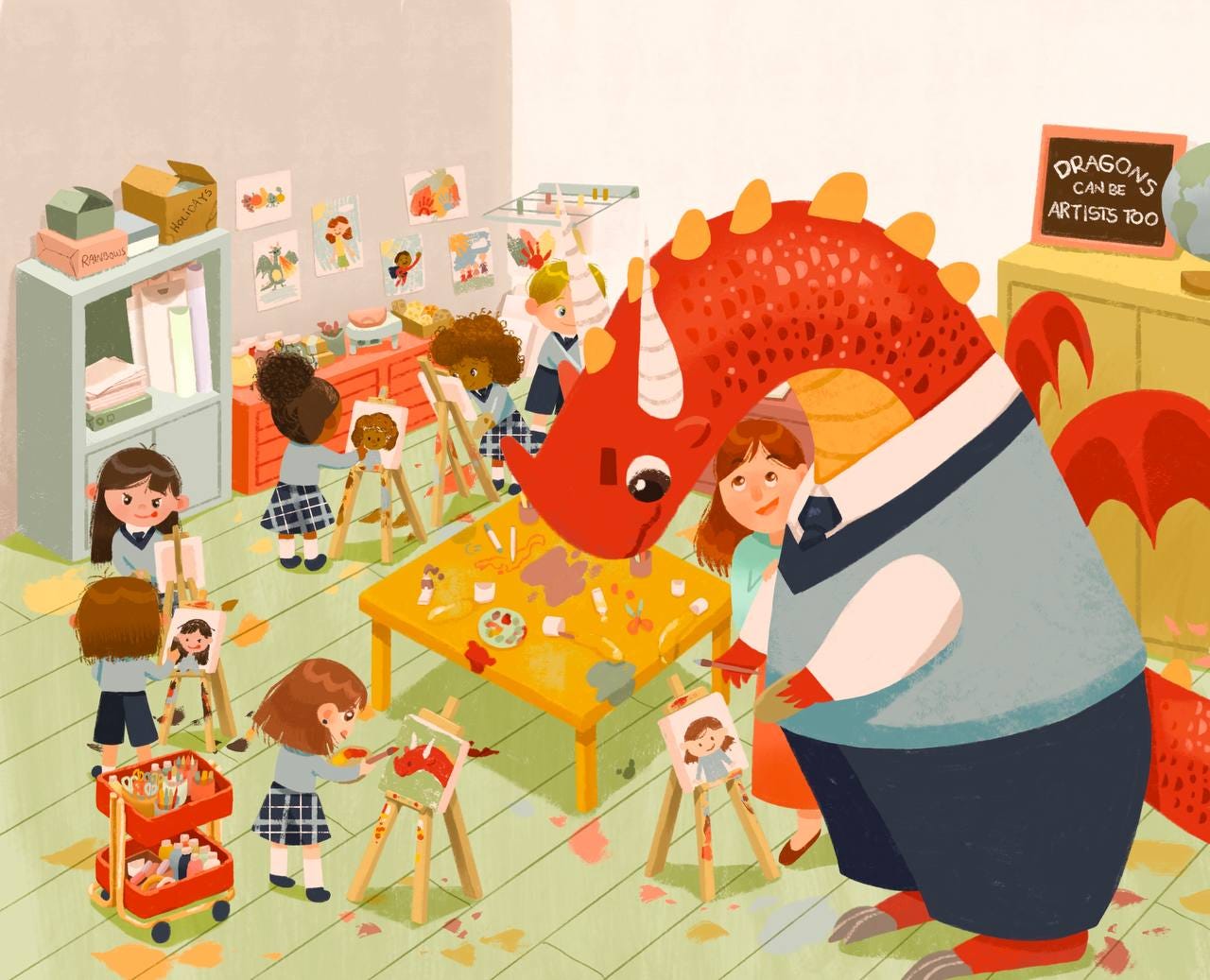What No One Tells You About Changing Your Art Style
The messy, uncomfortable, and ultimately rewarding journey of artistic growth
Changing your art style is a bit like changing your haircut—it seems like a natural process, sometimes even convenient. It can happen organically or stem from a conscious decision to explore new directions. But as always, it’s not all sunshine and rainbows; sometimes it’s uncomfortable, confusing, and a little scary.
The Discomfort of Change
When you start experimenting with something different, it feels weird. What used to be automatic now takes effort. Your hand and mind want to return to what they know, but another part of your brain—clumsy yet determined—insists that you should try something new. Sometimes, what you envisioned in your head doesn’t translate well onto paper, and frustration creeps in fast.
It feels like unlearning everything you knew. Suddenly, everything looks more awkward, less polished. Am I regressing? Is it normal that I can’t get it right yet? These questions circle in my mind, but I recognize that change comes with an uncomfortable phase where everything feels worse before it starts to feel natural again. And even more so as a neurodivergent person, where patterns and familiarity feel so safe.
Sometimes, I even find myself mourning my old style. Looking at past illustrations and thinking, this looks better than what I’m making now can be discouraging. But I try to remind myself that this is just a transitional phase and that every sketch, every experiment, brings me closer to something that truly resonates with me.
Impostor Syndrome and Identity Crisis
"Is this really my style? Will people still recognize my work if I change too much?" These questions appear now that I’m starting to move away from what I used to do. Sometimes, I fear losing my artistic identity, and that fear holds me back from exploring freely. But my style isn’t a prison—it’s a tool. And tools can change depending on what we want to create.
We often associate our art style with our identity as an artist, as if it were something fixed. But art is an extension of who we are at any given moment, and just as we change as people, it’s natural for our art to change too. Perhaps the most important thing is learning to embrace that fluidity instead of resisting it.
Unlearning Old Habits and Finding New Ones
The way I use color, the structure of my compositions, the linework I rely on—these are all habits built over time. And when I decided to change, I realized I had to unlearn certain things and find new ways to work. That takes time, and sometimes my brain screams at me that I don’t have time.
I also worry that my new style won’t appeal to my followers or past clients. I guess it’s normal to be concerned about this, but no artist remains static forever. Evolution is part of the process, right? Sometimes, finding a style that aligns better with both the market and what you truly enjoy can open new doors rather than close them.
Through this process, I’ve also realized how much I rely on certain "tricks" to make my art look "good" quickly. Letting go of those tricks to try something new makes me feel vulnerable, like I’m starting from scratch. But it’s also exciting to think about all the possibilities that open up when you allow yourself to learn again.
Small Moments of Clarity
Still, amidst all the chaos, there are small moments where something clicks. A drawing that suddenly feels right, or a texture that works perfectly. I take these moments as signs that the change is working.
Those moments—when an unexpected brushstroke looks just right, or when a color combination I’ve never used before suddenly makes sense—remind me why I’m doing this. They prove that even though the process is hard, it can also be deeply rewarding.
Tips for Navigating the Change
Give it time – You won’t find your new artistic voice overnight. Allow yourself to explore without pressure.
Embrace the awkward phase – We all go through a transition period where nothing seems to work. It’s just part of the process.
Don’t cling to labels – You don’t have to lock yourself into a single style. Let it evolve naturally.
Keep creating – The only way to adapt to a new style is to keep drawing. Don’t let frustration stop you.
Find inspiration in other artists – Seeing the work of others who have gone through similar changes can be a reminder that you’re not alone.
Don’t compare your process to others – Every artist has their own pace and journey. What matters is moving forward in your own way.
Changing your art style—and change in general—is hard. But it’s a reminder that art is a living, ever-evolving process. And even though the path isn’t always clear, in my opinion, the evolution is worth it.
Lo que nadie te dice sobre cambiar de estilo
Cambiar de estilo es un poco como cambiar de corte de pelo, parece un proceso natural, conveniente incluso a veces. Puede surgir de manera orgánica o de alguna decisión consciente para explorar nuevas direcciones. Pero como siempre, no todo es color de rosa y a veces es incómodo, confuso y da miedito.
La incomodidad del cambio
Cuando empiezas a probar algo diferente, se siente raro. Lo que era antes automático ahora requiere esfuerzo. Tu mano y tu mente quieren volver a lo conocido, pero otra parte de tu cabeza, igual de torpe, dice que tienes que probar algo nuevo. A veces también pasa que la idea que tenías en la cabeza no se traduce bien al papel, y la frustración aparece rápido.
Es como desaprender todo lo que sabías. De repente, todo se ve más torpe, menos pulido. ¿Estoy retrocediendo? ¿Es normal que no me salga bien todavía? Esas preguntas rodean mi mente, pero reconozco que el cambio viene con una fase incómoda en la que todo se siente peor antes de acostumbrarse. Y más aún siendo neurodivergente, donde los patrones y la familiaridad pueden sentirse tan seguros.
A veces también me encuentro con una especie de "duelo" por mi estilo anterior. Ver ilustraciones pasadas y pensar "esto se ve mejor que lo que estoy haciendo ahora" es desalentador. Pero intento recordar que es solo una fase transitoria y que cada boceto, cada experimento, me lleva más cerca de algo que realmente resuene conmigo.
El síndrome del impostor y la crisis de identidad
“¿Este es realmente mi estilo? ¿Me reconocerán si cambio demasiado?” Son preguntas que aparecen ahora que empiezo a alejarme de lo que hacía antes. A veces, me da miedo perder mi identidad visual y eso me impide explorar libremente. Pero mi estilo no es una prisión, es una herramienta. Y las herramientas pueden cambiar según lo que queremos crear.
Muchas veces asociamos nuestro estilo con nuestra identidad como artista, como si fuera algo fijo. Pero el arte es una extensión de lo que somos en cada momento, y así como cambiamos como personas, es natural que nuestro arte también lo haga. Quizás lo más importante es aprender a abrazar esa fluidez en lugar de luchar contra ella.
Desaprender hábitos y encontrar nuevos
Los trazos rígidos, la forma en la que uso el color, cómo estructuro mis composiciones… Todos son hábitos que se adquieren con el tiempo. Y cuando decidí cambiar, pues hay que desaprender ciertas cosas y encontrar nuevas maneras de trabajar. Y eso toma tiempo, y a veces mi cerebro me grita que no tengo tiempo.
También tengo el miedo de que dejaré de gustarle a mis seguidores o a mis antiguos clientes. Supongo que es normal preocuparse por esto, pero ningún artista permanece estático toda su vida. La evolución es parte del proceso, ¿no? Muchas veces encontrar un estilo más alineado con el mercado y con lo que disfrutas puede abrir nuevas oportunidades en lugar de cerrarlas.
En este proceso también me he dado cuenta de cuánto dependo de ciertos trucos para hacer que mi arte se vea "bien" rápidamente. Dejar esos trucos atrás para probar algo nuevo me hace sentir vulnerable, como si estuviera comenzando desde cero. Pero también es emocionante pensar en todas las posibilidades que se abren cuando te permites aprender de nuevo.
Pequeños momentos de iluminación
Igual, en medio del caos, hay pequeños momentos en los que algo hace clic. Una ilustración que se siente correcta de repente, o una textura que funciona. Estos momentos los tomo como señal de que el cambio está funcionando.
Esos instantes donde un trazo inesperado queda perfecto o donde una combinación de colores que nunca había usado antes cobra sentido, son los que me recuerdan por qué estoy haciendo esto. Son una prueba de que, aunque el proceso sea difícil, también puede ser profundamente satisfactorio.
Consejos para navegar el cambio
Dale tiempo: No vas a encontrar tu nueva voz artística de un día para otro. Permítete explorar sin presión.
Acepta la etapa torpe: Todos pasamos por un periodo de transición en el que nada parece salir bien. Es parte del proceso.
No te aferres a etiquetas: No necesitas encasillarte en un solo estilo. Déjalo evolucionar de forma natural.
Sigue creando: La única forma de adaptarte a un nuevo estilo es seguir dibujando. No dejes que la frustración te frene.
Encuentra inspiración en otros artistas: Ver el trabajo de otros que han pasado por cambios similares puede ser un recordatorio de que no estás solo en esto.
No compares tu proceso con el de los demás: Cada artista tiene su propio ritmo y camino. Lo importante es seguir avanzando a tu manera.
Cambiar de estilo, el cambio en general, es difícil. Pero es un recordatorio de que es un proceso vivo, en constante transformación. Y aunque el camino no siempre sea claro, la evolución en mi opinión merece la pena.
¿Has pasado por un cambio de estilo recientemente? Me encantaría leer sobre tu experiencia. 😊








Thank you for your article, I can relate to this very much. I myself am also experiencing confusion and uneasiness about art style changes. One of my main problems is just like what you mentioned in your article. Rationally, I know that art style doesn’t develop overnight. But emotionally, I don't think I have time to wait for a style to slowly evolve. I wish I could be a little more patient with myself and just practice. Thank you for the tips for navigating the change, they are truly helpful! :)